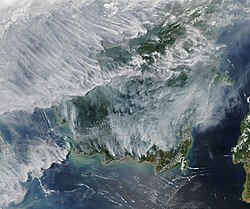
| Southeast Asian haze series |
|---|
 |
| History |
| Key topics |
| Responses |
| See also |
|
|
The chemical equator term and concept was coined in 2008 when researchers from University of York discovered a distinct divide between the polluted air and haze over Indonesia from the largely uncontaminated atmosphere over Australia. This divide is distinguishable by a rapid increase in atmospheric levels of carbon monoxide and other pollutants from the Tropical Warm Pool region northward.[1] The divide of the atmosphere of the northern hemisphere from the atmosphere of the southern hemisphere is different from that of the Intertropical Convergence Zone.[2]
- ^ Hamilton, Jacqueline F.; Allen, Grant; Watson, Nicola M.; Lee, James D.; Saxton, Julie E.; Lewis, Alastair C.; Vaughan, Geraint; Bower, Keith N.; Flynn, Michael J.; Crosier, Jonathan; Carver, Glenn D. (2008). "Observations of an atmospheric chemical equator and its implications for the tropical warm pool region" (PDF). Journal of Geophysical Research. 113 (D20): D20313. Bibcode:2008JGRD..11320313H. doi:10.1029/2008JD009940. ISSN 0148-0227.
- ^ University of York, 2008, 'Chemical Equator' Discovery Will Aid Pollution Mapping: Science Daily: https://www.sciencedaily.com/releases/2008/09/080923091339.htm (accessed November 2021).